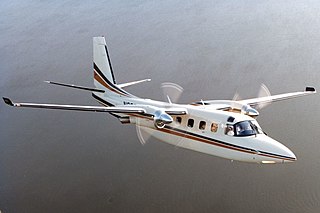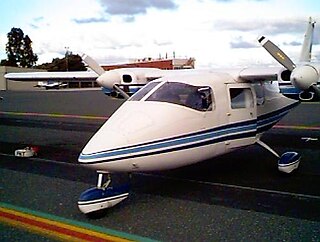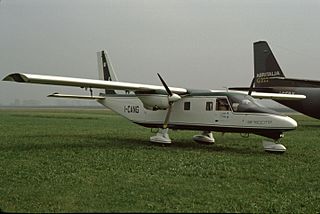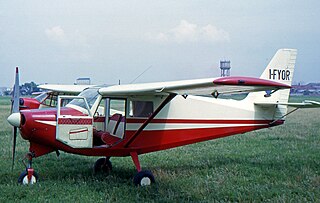
The Aero Commander 500 family is a series of light-twin piston-engined and turboprop aircraft originally built by the Aero Design and Engineering Company in the late 1940s, renamed the Aero Commander company in 1950, and later a division of Rockwell International in 1965. Final production occurred under the Gulfstream Aerospace name. The initial production version was the 200 mph, seven-seat Aero Commander 520. An improved version, the 500S, manufactured after 1967, is known as the Shrike Commander. Larger variants are known by numerous model names and designations, ranging up to the 330 mph, 11-seat Model 695B/Jetprop 1000B turboprop. As of recent, the Aero Commander is known as the Twin Commander.

The Piper M-Class is a family of American light aircraft manufactured by Piper Aircraft of Vero Beach, Florida. The aircraft are powered by single engines and have six seats. Twentieth century production of the class was all piston engined, but turboprop versions called the M500, M600 and M700 (Fury) are now also available.

The Piper PA-44 Seminole is an American twin-engined light aircraft manufactured by Piper Aircraft.

The Piper PA-31 Navajo is a family of twin-engined utility aircraft designed and built by Piper Aircraft for small cargo and feeder airlines, and as a corporate aircraft. Production ran from 1967 to 1984. It was license-built in a number of Latin American countries.

The Cessna 421 Golden Eagle is an American six or seven seat twin-engined light transport aircraft, developed in the 1960s by Cessna as a pressurized version of the earlier Cessna 411.

The Beechcraft Queen Air is a twin-engined light aircraft produced by Beechcraft in numerous versions from 1960 to 1978. Based upon the Twin Bonanza, with which it shared key components such as wings, engines, and tail surfaces, it had a larger fuselage, and served as the basis for the highly successful King Air series of turboprop aircraft. Its primary uses have been as a private aircraft, utility, and small commuter airliner. Production ran for 17 years.

The Sky Arrow is a tandem two-seat, high-wing pusher light aircraft that was manufactured by 3I.

Vulcanair is an Italian aircraft manufacturer based in Casoria, near Naples.

The Partenavia P.64B/P.66B Oscar is an Italian two/four-seat, single-engined, high-wing monoplane built by Partenavia.

The Piaggio P.166 is an Italian twin-engine pusher-type utility aircraft developed by Piaggio Aero. The aircraft model name was Portofino, and is also known as Albatross in South African military service.

The AS/SA 202 Bravo is a two to three-seat civil light aircraft jointly designed and manufactured by the Swiss company Flug- und Fahrzeugwerke Altenrhein (FFA) and the Italian company Savoia-Marchetti. The aircraft was designated the AS 202 in Switzerland, and the SA 202 in Italy.

The type designation Dornier Do 28 comprises two different twin-engine STOL utility aircraft, manufactured by Dornier Flugzeugbau GmbH. Most of them served with the German Air Force and Marineflieger and other air forces around the world in the communications and utility role. The Do 28 series consists of the fundamentally different Do 28 A/B (1959) and Do 28 D Skyservant (1966).

The Vulcanair SF.600 Canguro was a feederliner developed in Italy in the late 1970s. Despite a number of attempts to put the aircraft into series production, only a small number were ever built. The Canguro was a high-wing cantilever monoplane of conventional configuration with a fuselage of rectangular cross-section and a high-set tail. The tricycle undercarriage was not retractable, and its main units were carried on sponsons on the fuselage sides. SIAI Marchetti provided funding towards the construction of the prototype, and constructed this aircraft at the former Aviamilano plant. After flight testing proved positive, the type was put on sale, but failed to attract buyers in any number, even when the original piston engines were exchanged for turboprops and retractable undercarriage was offered as an option.
The Partenavia P.55 Tornado was a 1950s Italian high-performance competition and touring monoplane built by Partenavia. The Tornado was a small mid-wing cantilever monoplane with a retractable tricycle landing gear. The aircraft was powered by a nose-mounted Lycoming O-320 piston engine.

The Partenavia P.57 Fachiro is an Italian, four-seat, high-wing, touring monoplane, fitted with a fixed tricycle undercarriage.

The Honeywell T55 is a turboshaft engine used on American helicopters and fixed-wing aircraft since the 1950s, and in unlimited hydroplanes since the 1980s. As of 2021, more than 6,000 of these engines have been built. It is produced by Honeywell Aerospace, a division of Honeywell based in Scottsdale, Arizona, and was originally designed by the Turbine Engine Division of Lycoming Engines in Stratford, Connecticut, as a scaled-up version of the smaller Lycoming T53. The T55 serves as the engine on several major applications including the CH-47-Chinook, the Bell 309, and the Piper PA-48 Enforcer. The T55 also serves as the core of the Lycoming ALF 502 turbofan. Since the T55 was first developed, progressive increases in airflow, overall pressure ratio, and turbine inlet temperature have more than tripled the power output of the engine.
The Hongdu N-5,, originally known as the Nanchang N-5, is a Chinese agricultural aircraft. First flown in 1989, and entering into production in 1992, the N-5 is a single-engined low-wing monoplane, and is available in versions powered by a piston engine or a turboprop.

The Tecnam P2006T is an Italian high-winged twin-engined all-metal light aircraft, built by Costruzioni Aeronautiche Tecnam based in Capua, Italy, near Naples. The P2006T received airworthiness certification in the European Union by EASA under CS23 in 2003, type certification in 2009, and Federal Aviation Administration FAR Part 23 certification in 2010.
The ECi O-320 is part of a family of normally aspirated, air-cooled, four-cylinder, direct-drive engines developed for certified and experimental aircraft. Its cylinders are arranged in horizontally opposed configuration and a displacement of 320 cubic inches (5.24 L). It is based on the Lycoming O-320 engine with ECi cylinder assemblies.

The Vulcanair V1.0 is an Italian light aircraft, designed and produced by Vulcanair of Casoria, introduced at the AERO Friedrichshafen show in 2014. The aircraft is type certified by the European Aviation Safety Agency and the US Federal Aviation Administration and is supplied complete and ready-to-fly.

























